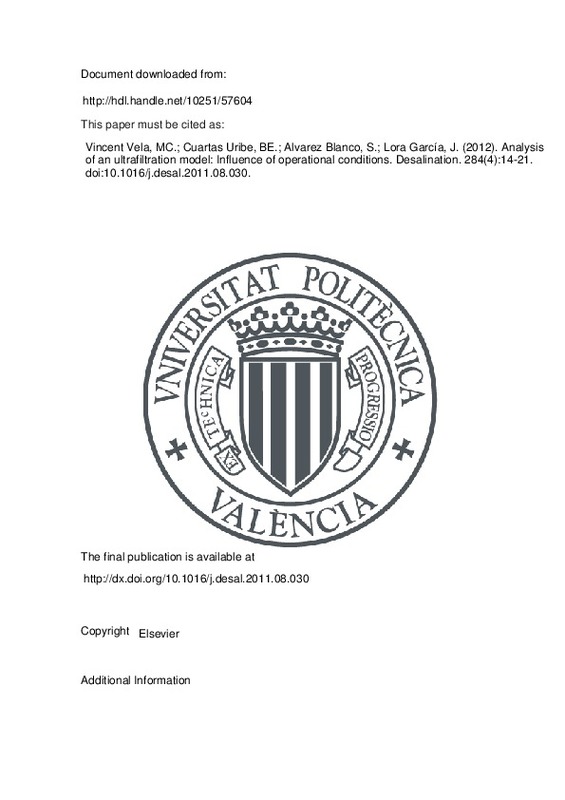JavaScript is disabled for your browser. Some features of this site may not work without it.
Buscar en RiuNet
Listar
Mi cuenta
Estadísticas
Ayuda RiuNet
Admin. UPV
Analysis of an ultrafiltration model: Influence of operational conditions
Mostrar el registro sencillo del ítem
Ficheros en el ítem
| dc.contributor.author | Vincent Vela, Maria Cinta
|
es_ES |
| dc.contributor.author | Cuartas Uribe, Beatriz Elena
|
es_ES |
| dc.contributor.author | Alvarez Blanco, Silvia
|
es_ES |
| dc.contributor.author | Lora García, Jaime
|
es_ES |
| dc.date.accessioned | 2015-11-17T11:41:05Z | |
| dc.date.available | 2015-11-17T11:41:05Z | |
| dc.date.issued | 2012-01-04 | |
| dc.identifier.issn | 0011-9164 | |
| dc.identifier.uri | http://hdl.handle.net/10251/57604 | |
| dc.description.abstract | Ultrafiltration is a widely used technique to remove hazardous pollutants from wastewaters. As ultrafiltration is a dynamic process, non steady-state UF models have been widely investigated and described in the literature. The main equations of most dynamic models found in the literature can be rearranged and simplified into a linear equation. In this work, experimental results from UF tests were expressed in terms of TMP2/J(P)(2) as a function of time to check linearity. Transmembrane pressure (TMP), feed concentration (FC), temperature and crossflow velocity (CFV) were varied during the experiments. The feed consisted in an aqueous solution of polyethylene glycol of 35 kg/mol molecular weight. The experimental results confirmed a linear relationship when TMP2/J(P)(2) was plotted vs. time. For severe fouling conditions, the linearity found when plotting experimental values of initial membrane fouling resistance vs. TMP was very high. A linear correlation between the initial membrane fouling resistance and the temperature was also found for the experimental conditions tested. However, it was found that, above 25 degrees C, increasing temperature did not result in a noticeable reduction of the gel layer resistance. The quotient r(c)/r(g) as a function of TMP and CFV was also evaluated to check if it followed any pattern. (C) 2011 Elsevier B.V. All rights reserved. | es_ES |
| dc.language | Inglés | es_ES |
| dc.publisher | Elsevier | es_ES |
| dc.relation.ispartof | Desalination | es_ES |
| dc.rights | Reserva de todos los derechos | es_ES |
| dc.subject | Model | es_ES |
| dc.subject | Ultrafiltration | es_ES |
| dc.subject | Initial membrane fouling resistance | es_ES |
| dc.subject | Gel layer | es_ES |
| dc.subject.classification | INGENIERIA QUIMICA | es_ES |
| dc.title | Analysis of an ultrafiltration model: Influence of operational conditions | es_ES |
| dc.type | Artículo | es_ES |
| dc.identifier.doi | 10.1016/j.desal.2011.08.030 | |
| dc.rights.accessRights | Abierto | es_ES |
| dc.contributor.affiliation | Universitat Politècnica de València. Departamento de Ingeniería Química y Nuclear - Departament d'Enginyeria Química i Nuclear | es_ES |
| dc.description.bibliographicCitation | Vincent Vela, MC.; Cuartas Uribe, BE.; Alvarez Blanco, S.; Lora García, J. (2012). Analysis of an ultrafiltration model: Influence of operational conditions. Desalination. 284:14-21. doi:10.1016/j.desal.2011.08.030 | es_ES |
| dc.description.accrualMethod | S | es_ES |
| dc.relation.publisherversion | http://dx.doi.org/10.1016/j.desal.2011.08.030 | es_ES |
| dc.description.upvformatpinicio | 14 | es_ES |
| dc.description.upvformatpfin | 21 | es_ES |
| dc.type.version | info:eu-repo/semantics/publishedVersion | es_ES |
| dc.description.volume | 284 | es_ES |
| dc.relation.senia | 207820 |







![[Cerrado]](/themes/UPV/images/candado.png)

